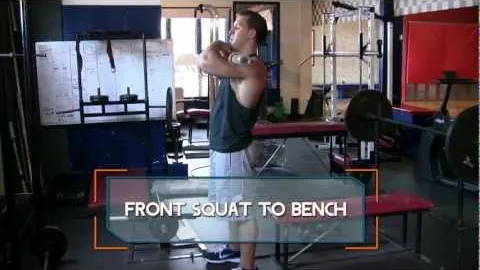
The front squat to bench exercise is an effective compound movement that targets your lower body, particularly your quadriceps, glutes, and hamstrings. It is a variation of the traditional front squat exercise, but with the added benefit of incorporating a bench or box for added stability and depth control. In this comprehensive guide, we will break down the front squat to bench exercise, its benefits, proper form and technique, variations, and tips for maximizing your results.
Strength Building: The front squat to bench exercise is a fantastic way to build lower body strength. By incorporating the bench or box, you are increasing the stability of the movement, allowing you to lift heavier weights and challenge your muscles even more.
Improved Quad Development: This exercise places a significant emphasis on the quadriceps muscles, helping you to develop stronger and leaner legs.
Increased Glute Activation: The front squat to bench exercise engages the glute muscles, helping to shape and define your backside.
Enhanced Core Stability: To properly execute this exercise, you need to engage your core muscles to maintain balance and stability. This, in turn, helps to strengthen your abdominal muscles and improve your overall core stability.
Functional Strength: This compound movement closely mimics everyday activities that require lower body strength, such as standing up from a seated position or carrying heavy objects.
To maximize the benefits of the front squat to bench exercise and prevent injury, it is crucial to maintain proper form and technique. Follow these steps:
Set up: Position your feet slightly wider than shoulder-width apart, with your toes pointed slightly outward. Hold the barbell across the front of your shoulders, resting it on the clavicles and the fingertips. Keep your elbows high throughout the movement.
Descent: Begin the movement by lowering yourself into a squat position, keeping your chest up, core engaged, and knees tracking over your toes. Sit back as if you were sitting on a bench, making sure to keep your weight centered over your midfoot.
Depth: Descend until your glutes barely touch the bench or box, ensuring that it does not take the weight off your muscles. Maintain tension in your muscles by not relaxing on the bench.
Ascent: Drive through your heels, pushing your hips forward and explosively standing up to the starting position. Keep your entire body tight throughout the movement, maintaining the correct alignment of your spine.
To add variety to your training and target different muscle groups, consider these variations of the front squat to bench exercise:
1. Dumbbell Front Squat to Bench: Instead of using a barbell, hold two dumbbells at shoulder height. This variation places additional emphasis on improving stability and balance.
2. Goblet Front Squat to Bench: Hold a kettlebell or a dumbbell with both hands in front of your chest to perform this variation. It is an excellent alternative for beginners or those with limited mobility.
3. Single-Leg Front Squat to Bench: Increase the difficulty and challenge your stability by performing the front squat to bench exercise on one leg at a time. This variation helps to address muscle imbalances and improve overall athleticism.
Here are some tips to get the most out of your front squat to bench exercise:
Warm-Up Properly: Prior to any resistance training, it is essential to warm up your muscles to prevent injury and maximize performance. Perform dynamic stretches and light exercises to activate your muscles and increase blood flow.
Focus on Technique and Progression: Start with lighter weights and master your technique before gradually increasing the load. Make progressive overload a priority to continue challenging your muscles.
Mind-Muscle Connection: Concentrate on feeling the tension in your quads, glutes, and hamstrings throughout the movement. This will help you engage the targeted muscles more effectively.
Maintain Proper Breathing Technique: Inhale deeply before descending into the squat position, and exhale forcefully as you stand up. This breathing pattern helps stabilize your core and maintain proper form.
Recovery and Rest: Allow your muscles to recover and grow by scheduling adequate rest days in between your training sessions. Get enough sleep and nourish your body with proper nutrition to support muscle repair and growth.
The front squat to bench exercise is an exceptional compound movement that can help you build strength, stability, and muscle mass in your lower body. By incorporating this variation into your workout routine, you can target your quadriceps, glutes, and hamstrings effectively. Focus on your form, progress gradually, and listen to your body. With consistency and dedication, you can reap the benefits and take your fitness journey to new heights.
If you're looking for a gym, fitness club or yoga studio, you've come to the right place.
You can find information about gyms in your area. Browse catalog of gyms and find gyms with classes which are you looking for.
On gym page you can find simple information like address, phone or website. You can find list of available classes. You can check availability of personal training or small group classes. On place page you can also see information about open hours.
You can find gyms near you with amenities, courts, studios and equipments.
Use our map to find gym at your city or district.
In Gym Navigator you can find list of exercises with movies for many body parts.
You can browse exercises catalog and find exercises the best of you.
You can also find exercises grouped into workout plans, which you can use to improve you body. Each routine show you exercises one by one and give you possibility to count you progress and count down rest time.